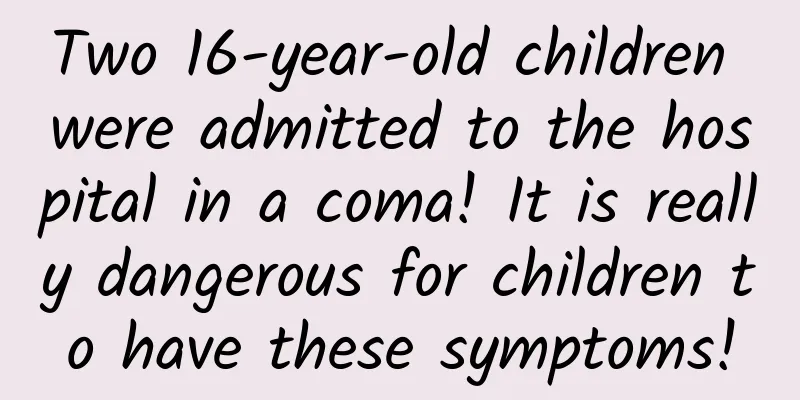Two 16-year-old children were admitted to the hospital in a coma! It is really dangerous for children to have these symptoms!

|
Shortly after the summer vacation ended, Zhejiang Medical Health Hangzhou Hospital successively received two 16-year-old adolescent patients with "sugar obesity". One of the boys was treated for coma and was eventually diagnosed with "type 2 diabetic ketoacidosis, obesity, perianal abscess", etc. He is 1.7 meters tall, weighs 200 catties, and has a body mass index (BMI) of 34.6kg/m2. Another girl has a history of "type 2 diabetes" for more than 4 years. She usually takes metformin tablets, but fails to cooperate with diet, exercise and lifestyle intervention, and has poor blood sugar control. This time, "perianal abscess" induced "diabetic ketoacidosis". She is 1.6 meters tall, weighs 144 catties, and has a body mass index (BMI): 28.1kg/m2. After joint treatment by the Department of Endocrinology and the Department of Anorectal Surgery of Zhejiang Medical Health Hangzhou Hospital, the two children were successfully discharged from the hospital after the acute complications and comorbidities were cured. "These two children are obese type 2 diabetes patients with a short course of illness. If they can have regular specialist follow-up visits, their weight can be reduced to an ideal range under the guidance of a scientific weight loss plan, and they can also adhere to a healthy diet and exercise lifestyle, they are fully expected to achieve 'diabetes reversal'." said Huang Weiyuan, director of the Department of Preventive Health Care/Health Education and deputy chief physician of the Department of Endocrinology of Zhejiang Medical Health Hangzhou Hospital . Diabetic ketoacidosis and ketoacidosis are both common and severe acute complications in patients with diabetes. When the patient's ketone bodies increase significantly, a large amount of reserve alkali in the body is consumed. Acidosis does not occur in the early stages of the disease. When the increased ketone bodies exceed the body's compensatory capacity, metabolic acidosis occurs. In mild cases, diabetic ketoacidosis and ketoacidosis can cause patients to experience nausea, fatigue, lack of energy and other discomfort symptoms. In severe cases, patients can experience abdominal pain, vomiting, extreme fatigue, increased breathing rate, increased heart rate, dehydration, shock and other symptoms, and even coma and life-threatening. In recent years, obesity in children and adolescents has become more and more common. Moreover, many "little fat guys" are considered by their parents, especially grandparents, to be simply "good-looking"! But in fact, the excessive weight gain is mostly circles of "fat". If there is a lack of attention and effective intervention in the early stage, the long-term harm that follows will make these so-called "good-looking" children suffer from chronic diseases such as diabetes, hyperuricemia, hyperlipidemia, and hypertension. The "Report on the Nutrition and Chronic Disease Status of Chinese Residents (2020)" released by the National Health Commission shows that the overweight and obesity rates among children and adolescents aged 6-17 in my country are nearly 20% in total, and the overweight and obesity rate among children under 6 years old is as high as 10%; compared with the report released in 2015, the overall overweight and obesity rates have increased, which fully demonstrates that the obesity situation among children and adolescents in my country is becoming more and more serious. The dangers of obesity in children and adolescents Affects growth and development Obesity can cause damage to multiple organs and systems, such as the bones and muscles. Obesity can also affect the reproductive and endocrine systems of children and adolescents, causing their puberty to develop earlier, and in severe cases, it can lead to precocious puberty. Affects brain and intellectual development A large number of studies have shown that the intelligence level of obese children is significantly lower than that of children with normal weight, and the more severe the obesity, the greater the impact on cognition and intelligence. Impact on athletic ability and development Obese children have relatively low lung capacity and their physical fitness is significantly lower than that of children of normal weight. Impact on mental health Obese children are often prone to some psychological problems. For example, they tend to suppress themselves, are prone to excessive inferiority complex, and are prone to loneliness. How to effectively prevent and control obesity among children and adolescents? The principle of obesity treatment is to reduce energy intake and increase energy expenditure, so that body fat is reduced and close to normal, while not affecting children's physical health and growth and development. For children with pathological obesity with clear causes or complications of obesity, treatment should be targeted at the causes or corresponding complications. Children and adolescents are in a critical period of growth and development, and dietary adjustments and increased exercise are the main ways to control weight. In preventing children from obesity, the family is the first line of defense, and parents are the first responsible person. Adjust your diet Correct children's bad eating habits and lifestyles, such as slowing down their eating speed, correcting their partial eclipse, avoiding overeating at dinner, reducing late-night snacks, processed snacks, fried foods, etc. A low-fat, appropriate carbohydrate and high-protein diet can meet children's basic nutrition, energy and growth and development needs. Enhanced exercise Healthy children and adolescents aged 6 to 17 should perform at least 60 minutes of moderate to high-intensity physical activity every day, mainly aerobic exercise, and perform at least 3 high-intensity physical activities and 3 resistance exercises (such as sit-ups, pull-ups, etc.) per week. The amount of exercise should be based on the principle of feeling relaxed and happy after exercise without feeling tired, and avoid strenuous exercise that increases appetite. Professional Assessment If you find that your child is gaining too much weight too quickly and looks chubby, you need to be alert to overweight or obesity and go to a regular medical institution for specialist evaluation to assess the following: ① Whether the child has reached the criteria for overweight or obesity in children and adolescents; ② Whether there is excessive fat accumulation or muscle growth; ③ Whether it is abdominal obesity, peripheral obesity or mixed obesity; ④ The severity of obesity; ⑤ Whether it has caused damage to other organ systems, especially abnormal glucose and lipid metabolism, non-alcoholic fatty liver, prehypertension, decreased cardiopulmonary function, abnormal puberty, etc. If the child is already obviously overweight or obese and has concurrent or combined diseases mentioned above, there is no need to worry too much. As long as you actively seek the help of specialists, it can be improved through professional diagnosis and management. |
>>: Don't be careless! These "small bumps" may induce cancer...
Recommend
If this part of a woman turns black, it must be due to gynecological diseases
As for dark circles under the eyes, most women th...
Can pregnant women massage their legs?
I believe that many pregnant women want to take a...
How to treat vulvar abscess
Gynecological diseases occur too frequently and c...
How long after the angiography can I have a child?
Angiography is a test method used to check whethe...
Menstrual disorders during menopause, do you understand these solutions?
When women reach menopause, their menstruation wi...
Can I use anesthesia during a normal birth?
Normal childbirth usually does not require anesth...
Monkeypox spreads to 30 countries. Will it become a new pandemic?
It is indeed a challenge, but there is no need to...
Is low-carb diet effective for weight loss? How to eat a low-carb diet
The hot summer is a good season for beauty-loving...
Will the clutch become hard if you often drive in low gear? Under what circumstances will the clutch become hard?
When it comes to our car driving, especially manu...
Do you know the secret of rhinitis and snoring?
When it comes to rhinitis, many friends may say: ...
How to take care of yourself after autologous fat breast augmentation surgery
Women all desire plump breasts, but many women ar...
4-week normal hcg reference range
The hcg value of the human body will change with ...
Can I have a child if I have vaginitis?
If the symptoms of vaginitis are relatively mild,...
Why do I feel dizzy when I am 3 months pregnant?
When women first become pregnant, they will exper...
Can pregnant women use Suye polypeptide?
Suye is a micro-business product that has become ...









